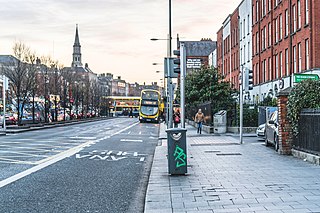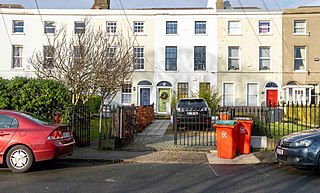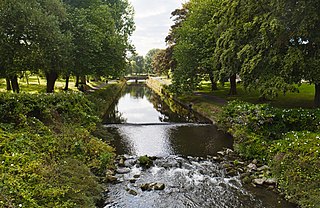
Glasnevin is a neighbourhood of Dublin, Ireland, situated on the River Tolka. While primarily residential, Glasnevin is also home to the National Botanic Gardens, Glasnevin Cemetery, the National Meteorological Office, and a range of other state bodies, and Dublin City University has its main campus and other facilities in and near the area. Glasnevin is also a civil parish in the ancient barony of Coolock.

The Northside in an informal but commonly used term to describe the part of the city of Dublin that lies to the north of the River Liffey, and extending into part of North County Dublin. The part outside the city is within the county of Fingal, a local government area established in 1994. While it is sometimes regarded as less wealthy than the city's Southside, the Northside was originally the home of the city's upper classes and the more privileged of the two. Today, some of the wealthiest areas in Ireland, such as Malahide, Howth, Clontarf, and Castleknock, lie north of the river.

Dorset Street is an important thoroughfare on the north side of Dublin, Ireland, and was originally part of the Slighe Midh-Luchra, Dublin's ancient road to the north that begins where the original bridging point at Church Street is today. Subsequently, yet prior to the street being given its current name in the 18th century, the road was known as Drumcondra Lane and was shown on maps as such. It is divided into Dorset Street Lower and Dorset Street Upper.

Drumcondra is a residential area and inner suburb on the Northside of Dublin, Ireland. It is administered by Dublin City Council. The River Tolka and the Royal Canal flow through the area.

Fairview is an inner coastal suburb of Dublin in Ireland, in the jurisdiction of Dublin City Council and in the city's D03 postal district. Part of the area forms Fairview Park, a recreational amenity laid out on land reclaimed from the sea.

Tolka Park is an Irish association football ground located in the north Dublin suburb of Drumcondra, on the northern banks of the River Tolka. It is currently the home ground of League of Ireland club Shelbourne. The stadium formerly held 9,680 people, but this has been scaled down in recent times due to health and safety regulations in the venue, mainly concerning the 'New' and Ballybough stands. Tolka Park has hosted national cup finals along with international matches, Champions League qualifiers, UEFA Cup, UEFA Cup Winners' Cup, UEFA Cup, UEFA Conference League ties and was a venue for the 1994 UEFA European Under-16 Championship and 2000 Rugby League World Cup. The ground has also in the past been used for boxing championships and basketball.

Santry is a suburb on the northside of Dublin, Ireland, bordering Coolock, Glasnevin, Kilmore and Ballymun. It straddles the boundary of Dublin City Council and Fingal County Council jurisdictions.

Ballybough is an inner city district of northeast Dublin city, Ireland. Adjacent areas include the North Strand and Clonliffe.

The River Tolka, also once spelled Tolga, is one of Dublin's three main rivers, flowing from County Meath to Fingal within the old County Dublin, and through the north of Dublin city, Ireland. By flow of water, the Tolka is the second largest river in Dublin, following the Liffey, but runs more slowly than the Dodder.

Drumcondra is a railway station on the Dublin Connolly to Longford and Grand Canal Dock to Newbridge commuter services. Almost all Sligo and Longford to Dublin services stop at Drumcondra.

Marino is an inner suburb on the Northside of Dublin, Ireland. It was built, in a planned form, on former grounds of Marino House, in an area between Drumcondra, Donnycarney, Clontarf, and what became Fairview. The initial development featured around 1,300 concrete-built houses.
Donnycarney is a Northside suburb in the city of Dublin, Ireland, in the jurisdiction of Dublin City Council. It is mostly residential, around 5 kilometres (3.1 mi) from the centre of Dublin. Dublin GAA's home stadium, Parnell Park, is located here.

Holy Cross College, located on Clonliffe Road, Drumcondra, was founded in 1854 as the Catholic diocesan seminary for Dublin by Paul Cullen, Archbishop of Dublin (later created, in 1866.
Clonturk is an area on the Northside of Dublin, in Ireland. It is located in the south of the suburb of Drumcondra, just north of the River Tolka, but previously, Clonturk had been an alternative name for Drumcondra and the wider area. Clonturk lies within the Dublin 9 postal district. The name Clonturk translates from the Irish as "Pasture of the boars". There is some evidence that the name originally was Ceann Torc or the "Headland of the boars", but had changed to Clonturk by the middle of the 16th century, perhaps under the influence of the more famous neighbouring placename Clontarf.
Drumcondra, Clonliffe and Glasnevin is a former second-tier local government area within County Dublin. It was created as a township in 1878. In 1899, it briefly became an urban district, before being abolished in 1900, with its area absorbed into the city of Dublin.

Griffith Park is a 7.5-hectare (19-acre) park located on the banks of the River Tolka in Dublin city between Glasnevin and Drumcondra. The park is a short distance downstream of Ireland's National Botanic Gardens, and upriver of Our Lady's Park, and has been noted by Discover Ireland as "one of the premier north city parks". The park closes at different times of the year, dependent on the hours of dusk.

Our Lady's Park is a small 0.37-hectare (0.91-acre) boomerang-shaped park located on the banks of the River Tolka in Dublin city next to Frank Flood Bridge in Drumcondra. The park is notable for its statue of the Virgin Mary, presumably erected in 1954 for the Marian Year which had been declared by Pope John XXIII.
The Drumcondra ambush was an attempted ambush carried out the Irish Republican Army (IRA) in Drumcondra, a suburb in northern Dublin, during the Irish War of Independence. On 21 January 1921, an IRA active service unit (ASU) initially set up an ambush near the Royal Canal in preparation for a British lorry which was travelling through the area. When the lorry failed to arrive, Frank Flood, the unit's commander, relocated his men up to a new position along the Tolka river. However, the IRA unit was spotted as they were setting up their new positions and a force of Auxiliaries was sent out, which resulted in 1 volunteer being killed and 5 others being arrested as they were attempting to escape.
















